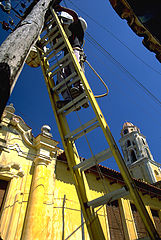How to Use a Ladder Safely
It’s important to understand how to use a ladder safely to prevent accidents and injuries. Falls from ladders are frequently listed as one of the top causes of accidents at home and in the workplace. Nearly all of these accidents could have been prevented with a little knowledge and application of basic ladder safety. If you are using a ladder at home or on the job, keep these safety tips in mind to help reduce your risk of injury:
Getting Started Safely
Use the right ladder for the job. Noting the ladder’s duty rating will ensure thatyou have selected the correct ladder for the job. Duty ratings place each ladder into one of thefollowing five categories:
| Duty Rating | Type | Maximum Weight |
|
3 | 200 lbs. |
|
2 | 225 lbs. |
|
1 |
250 lbs. |
|
1A | 300 lbs. |
|
1AA | 375 lbs. |
After you are certain that you have the right ladder for the job, and before each use, you should inspect the ladder thoroughly for damage or defects. Look closely at:
|
|
|
|
|
|
Working in an area free of loose material and debris is a must. Be sure to clear your work area prior to beginning the job. If you will be working with a ladder in close proximity to a door, be sure the door is locked, bolted, or guarded from opening.
Be aware of any sources of electricity or electrical equipment in the area. Considering that metal ladders conduct electricity, it’s best to use a wooden ladder instead of a metal one to minimize the risk of injury resulting from contact with an electrical current.
It is a good idea to familiarize yourself with how the locking mechanisms work on any extensional ladders. Before setting the ladder up on a foundational surface, be sure the locks are in good working order and are properly engaged.
Any ground or surface you plan to set the ladder on should be firm and level. Flat, wide boards can help achieve this when working on soft or slightly uneven ground. Never place a ladder on a box, chair, or any other unstable surface.
For maximum stability, a 75 degree angle should be used when setting an extension, straight, or single ladder. Using the 1:4 ratio as a guide is an ideal way to promote safety when working on a ladder. In other words, the base of your ladder should be one foot away from whatever it is leaning against for every four feet to the top of the ladder.
Using Ladders Safely Means Using Extreme Caution
Ladders are inherently dangerous and using caution will minimize your risk of injury. Never use a ladder for anything other than its intended purpose and always be sure to use the correct ladder for the job. Review the additional tips below to help you better understand how to use a ladder safely:
- When considering the maximum weight for your ladder, be sure to factor in the total weight of both the user and the materials.
- Stay centered. Try not to step or work outside of the center of the ladder. Do not reach to far to the left or right – instead move down the ladder and relocate it to a better position.
- Never step on the top step or place your weight on the bucket shelf. Do not ascend or descend the rear section of a step ladder.
- When going up or down, be sure to face into the ladder, not away.
- If you ever feel tired or dizzy, descend the ladder slowly and carefully.
- Sturdy non-slip footwear should be worn at all times when using a ladder. Wearing dress shoes, slip-on shoes, and tennis shoes on a ladder creates safety hazards.
Every year hundreds of people fall from ladders are seriously injured. Many of the injured will miss days, weeks, or months of work while in recovery. Knowing how to use a ladder safely will minimize these risks.
At Eaton & Berube, your safety is important to us. For additional safety tips and useful resources, please subscribe to our blog or contact us.

